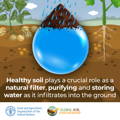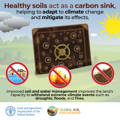"Man - despite his artistic pretensions, his sophistication, and his many accomplishments - owes his existence to a six inch layer of topsoil and the fact that it rains."
Soil and water are essential resources for sustaining life on Earth
Soil and water are the linchpins of food production, ecosystems, and human well-being. Understanding the importance of soil in this partnership and the latest findings is key to safeguarding these resources for future generations.
Soil is the unsung hero, often overshadowed by water, but its significance cannot be overstated. Let's understand the central role of soil:
● Nutrient Reservoir: Soil is not just a substrate; it's a reservoir of essential nutrients. Recent studies reveal the various processes by which soil stores and releases vital elements like nitrogen, phosphorus, and potassium for plant growth(1).
● Microbial Marvel: Healthy Soil is a bustling microbial community. The intricate web of microorganisms that facilitate nutrient cycling, enhance soil structure, and improve plant health is still being studied(2).
● Carbon Storehouse: Soil is Earth's largest terrestrial carbon sink. It has illuminated that soil has the potential to sequester carbon, mitigating climate change. Practices like agroforestry and organic farming can enhance soil's carbon storage capacity(3).
Soil Damage

Partners for Life

Soil for a Sustainable Future
While water often takes the limelight, soil is the unsung guardian of life and food security. Recent research has deepened our understanding of soil's vital roles as a nutrient reservoir, a carbon storehouse, and a microbial marvel. We must also acknowledge the threats of soil erosion and compaction, which compromise its capacity to work harmoniously with water. Safeguarding soil is not just an environmental imperative; it is the key to ensuring the food we eat and the ecosystems we depend on. By incorporating the recent findings and implementing responsible soil and water management practices, we can ensure a sustainable future where soil remains the steadfast partner in the dynamic bond with water, nurturing life and food security for generations to come.
Learn More On our youTube Channel
Root Rescue Learning Channel






